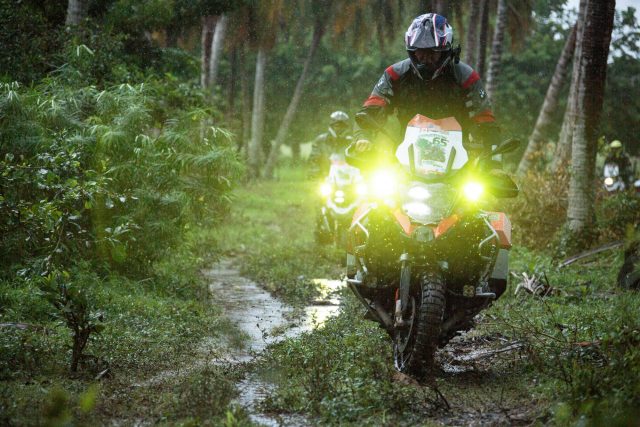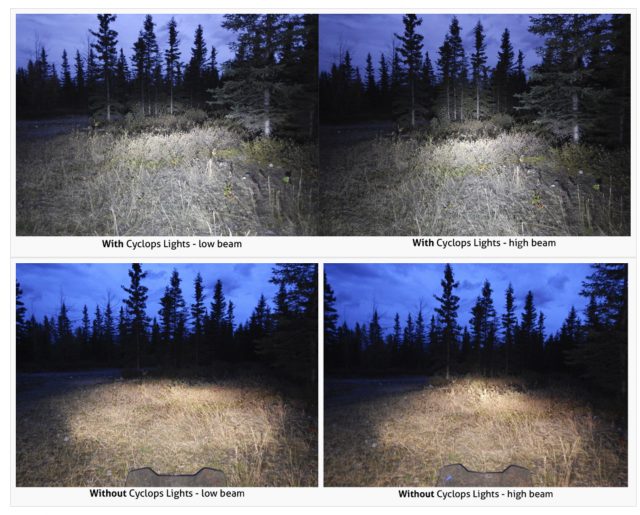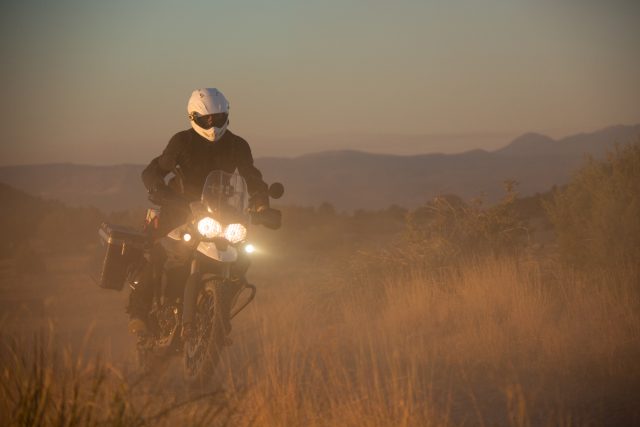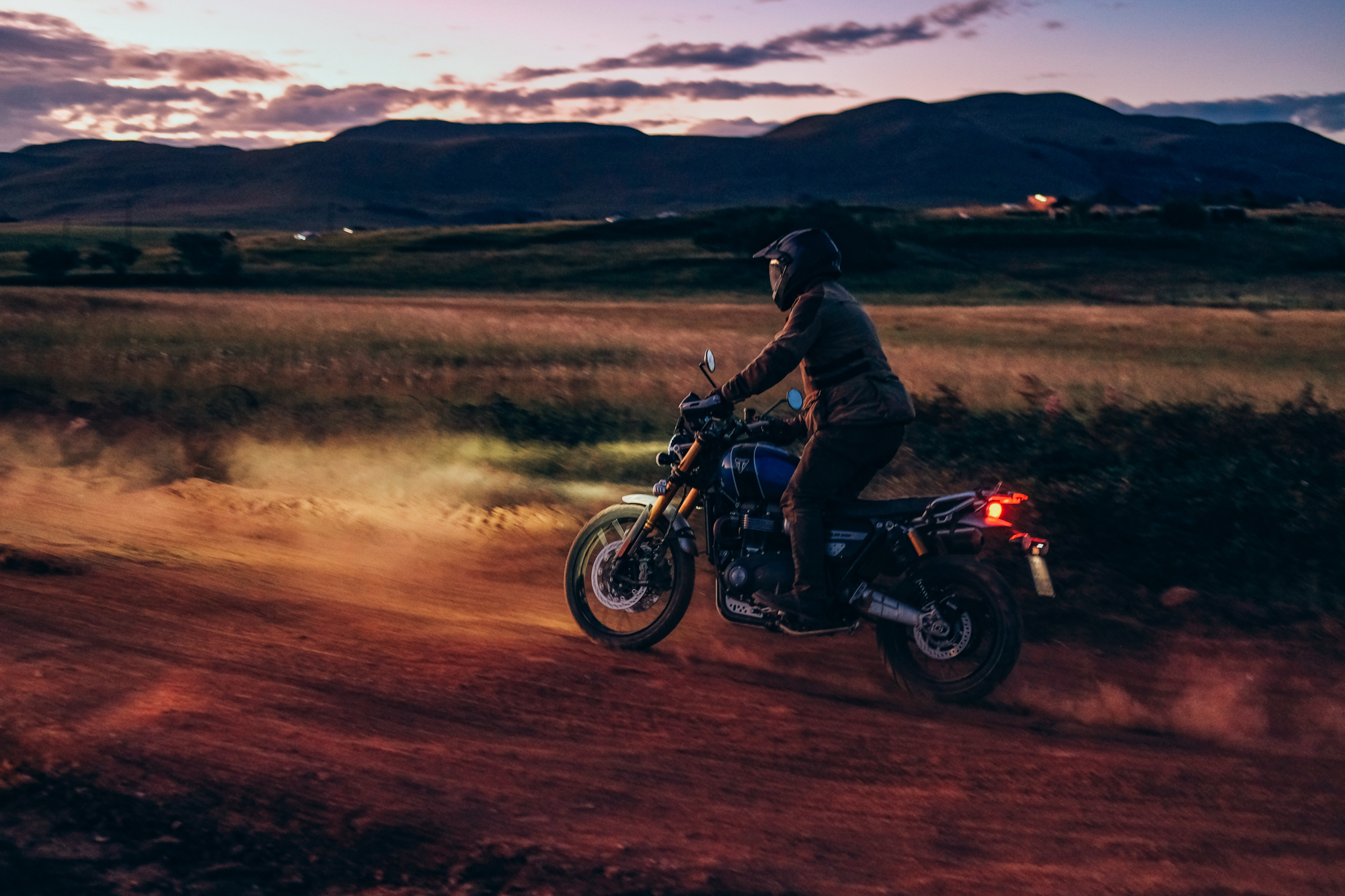Sometimes we have to—or even want to—ride in the dark or at other low-light times of the day, which makes it hard to be seen. What can we do about it? Light up that machine!

Before we get into some tips for being seen better while riding, let’s first look at some free or low-cost options and work with what you already have on your bike.
Use Your High Beams
At the very least, use your headlight during the day. But for extra caution, try popping on that high beam. Check the laws in your area, as this may be illegal where you live or are traveling. If not, your next step is courtesy and common sense. Blasting high beams into someone’s face or rearview mirror will not only annoy them but could blind them—even in the daytime. Use high beams during the day as you would at night, being considerate of oncoming cars and adjusting as needed.
Tap Your Brakes
You can install blinking LEDs that alert drivers in a sea of red lights during rush hour, but the free option is to just tap your brakes. The keyword here is “tap,” and it’s safer to use your foot on the rear brake. If you’d prefer to use your hand, only use one finger to avoid grabbing too much brake and weighting that front tire.
Add Reflective Tape To Your Helmet, Gear, And Bike
For a few dollars, you can help that noggin stand out with reflective stickers and tape. And while we’re on the subject of helmets, white or fluorescent lids are far easier to see down the road than black or gray. Adding reflective tape to your bike, luggage, and even your riding boots also helps.
Move Around
When stopped at traffic lights where you’re a sitting duck, stand up, move around, or even do a little dance to the music in your helmet. One issue for riders is we’re sometimes not seen as humans, especially when covered head to toe in armored gear and full-face helmets. Lift that visor up, look around, smile, and wave, if you feel like it. Make people aware of you and your two-wheeled steed.
But Don’t Be A Jerk
While riding through 40 countries in two years, I lashed out against idiot drivers I felt were trying to kill me. It’s hard not to when someone’s carelessness could cost you your life. I realized, however, that I was paying more attention to making them well aware of their mistake than actually riding safe enough not to hurt myself. Revving your engine, swerving back and forth in your lane, honking, and gesturing with that favorite finger doesn’t help the situation. If you’re an obnoxious jerk, people will want to run you off the road. Yes, you want to stand out, but not in a way that distracts drivers while they’re watching your circus performance on their commute. Make sure they’re aware of you, but don’t overdo it.
If you’re okay with spending some money for safety’s sake, try some or all of the following:
Wear Reflective Gear
Riders get into riding for many reasons but wearing bright orange, green, yellow, or pink may not be one of them. Everyone’s style is different, and if you’re not into high-vis gear, try the reflective tape option, making you more noticeable even in daylight. Most riding jackets now also come with reflection sewn into the back, shoulders, and chest. The goal is to mimic the humanoid form, and therefore humanize the rider.
Try High-vis Gear
Fluorescents truly stand out, and manufacturers are designing cool-looking high-vis gear nowadays. These suits can get up there in price. One way to knock it down is to purchase a high-vis vest you can throw on over any attire, which makes it versatile for hot- and cold-weather riding.
Install Blinking Brake Lights
Don’t forget about your rear end! Many of us kit out the front with brighter bulbs and auxiliaries, then forget about that undersized one at the back. Sometimes your brake light isn’t even visible if you’ve got luggage drooping over the pillion or luggage rack. Installing blinking lights on your tail will do everything that tapping your brake does—only you don’t have to think about it. Again, this may be against road laws where you live, so do your research.
Upgrade Bulbs
DOT-approved models are super bright and are said to increase two-way visibility, meaning what you see and how you’re seen, by six percent. Remember, it’s not just the headlight that should get upgraded. For whatever reason, most manufacturers affix tiny indicators and brake lights to bikes, so don’t leave these little guys out. You can even find LED indicators that not only blink brighter but also act as daytime running lights. Before buying, make sure to check your bike’s electric design to make sure the models will be compatible.

Install Auxiliary Lights
Some of these lights are designed for LEDs, which means they won’t throw off the headlight’s photometrics (the way the bulb reflects light) like using a halogen bulb might. Auxiliary lights also draw little power and do a great job of providing directional light, meaning not much light is wasted where you don’t need it.

Buy LED
For many reasons, LEDs are a great value. Aside from being long-lasting, LEDs are compact (allowing for more bulbs in a space), more efficient, less likely to be affected by vibration, and give better overall light coverage over what you want to see.
Update Dec. 21: DENALI has introduced front and rear signal pods: “[…] a shockingly bright amber turn signal with an integrated white DRL in the front and a red running and brake light in the back.” Check here for more on this product.
More Tips:
– Consider that riding at night isn’t the only time you may be hard to see on your bike. Rain, dust and fog can affect visibility, and dusk or dawn are also low-vis times of the day.
– When you see your shadow in front of you, that means the sun is at your back, and oncoming traffic may have a hard time seeing you. Be prepared to adjust speed and position if someone doesn’t see you.
– Stay warm and comfortable. If you’re cold, you’re distracted. Buying a heated vest, jacket, and/or gloves is not wimping out; it’s ensuring more of your concentration goes into riding.
– If you add weight—like another rider or luggage—onto the back of your bike, you may need to adjust the beam in your headlight as well as any auxiliaries, so they stay directional and don’t blind oncoming traffic.
– Try not to buy cheap no-name LEDs. They may not be DOT-approved, and they will wear out quickly. Find your local motorcycle store and give them some business. They’ll be more than happy to set you up and may provide advice and tips you won’t get from Amazon.
– Be careful about tricking out your bike too much. In many parts of the world, over-lighting your vehicle is illegal and will not only get you a ticket, but you’ll lose the money spent on all those fancy modifications.
Overall, remember the number one rule of riding a motorcycle—be conspicuous. People don’t see what they aren’t looking for.


